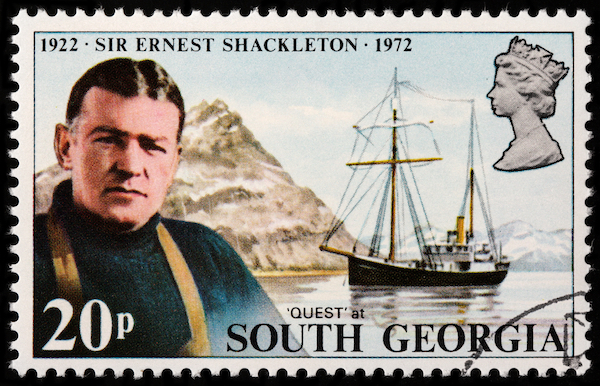Fifteen years ago, I was running the New York office of a leading digital agency, Organic, part of Omnicom.
If I am brutally honest, I was suffering a massive bout of impostor syndrome. Despite being in a leadership role for five years, I was still figuring it out, and it wasn’t going well.
The business was thriving, but I was not.
Although we had strong revenues, my office had low morale and high turnover. In an employee satisfaction study, my office was below average across all Omnicom agencies. Although I worked hard not to show it, I was pretty bloody miserable.
Thankfully, help was at hand and, surprisingly, in the shape of one of my all-time heroes, Ernest Shackleton.
More on this in a bit, but first, I had to go back to school.
Flipping My Thinking
Omnicom runs an excellent management program called Omnicom U. One of the key parts of this was a leadership program held at Babson College and run by senior Omnicom executives. My CEO sent me on the course at exactly the right time. I needed a different way of thinking about leadership.
While this program covered many aspects of running a modern agency, the focus was leadership. The faculty were mostly Harvard Business School professors. They did not disappoint. Each professor was brilliant and inspiring.
At the core of the program was a concept called the Service Profit Chain. This is a very boring name for a very powerful concept:
Committed employees lead to committed customers and that leads to greater profits.
Two things about this idea flipped the way I thought about leadership.
- Employees FIRST, not customers first. This was counter to everything that had been drilled into me for twenty years as an advertising account executive. The notion (and it’s obvious) is that having a team of committed and passionate employees delivering great work day in and day out leads to happy and committed customers. Not the other way round. Duh!
- COMMITTED not satisfied employees and COMMITTED customers not satisfied. Why? Because satisfied employees and customers are open to other offers and are more likely to leave you. Committed employees and customers stay with you longer, and stability underpins profitability. I had seen firsthand the impact of high employee turnover on customer dissatisfaction and profit.
But how do you create a committed workforce?
Lessons from Shackelton
The Harvard professors shared many different case studies on the Service Profit Chain, from a hernia clinic in Canada to examples across several Fortune 500 companies. The case study that cemented the idea for me was Shackleton’s ill-fated expedition to Antarctica.
Shackleton is one of my all-time heroes. I had read several books about his famous expedition, but I had yet to translate this into how to become a better leader.
The short version of this story is that Ernest Shackelton led twenty-eight explorers on an expedition to cross Antarctica. Their ship became trapped in the ice. After several months of living on the ice, the ship was crushed and sank. The expedition party escaped in the lifeboats to Elephant Island, a miserable ice-covered rock hundreds of miles from anywhere.
Shackleton’s next job was to get help. He organized his men to create shelter out of two of the lifeboats. They also fitted out one of the boats to sail it to an isolated whaling station on the island of South Georgia, where a rescue party would be organized.
Shackleton and five of his men crossed eight hundred miles of stormy seas and horrendous conditions in the Southern Atlantic with limited navigational equipment in a tiny little boat. This was an incredible feat of navigation. If they had been off course by a few degrees, they would have missed South Georgia. They would have perished and killed any chance of rescuing the men remaining on Elephant Island.
Shackleton reached South Georgia, but they landed on the wrong side of the island. He and two of the crew had to cross this mountainous, ice-covered island without anything approaching proper equipment and their clothes in rags. They reached the whaling station after two days with little to no sleep.
They organized a rescue ship but then had to wait three months for the right conditions to sail to Elephant Island and rescue the remaining crew.
All this time, the remaining crew on Elephant Island had no idea if Shackleton had made it and whether or not they would be rescued.
After a year of one existential adversity after another, the whole crew was rescued and returned home.
The most amazing thing about this nightmare is that they all survived.
The key to this was Shackleton’s leadership.
Throughout the year-long ordeal, Shackleton kept the twenty-eight men working as a well-organized functioning crew. Throughout, they kept up their morale and they never lost hope. Even when he was gone for three months to get help, the remaining crew carried on without him.
Breaking Down the Lessons from Shackelton
The Shackleton story has taught me a great deal about overcoming adversity. Revisiting this story during the leadership program helped me realize how the key to leadership is about doing several things well.
Shackleton had many qualities, but arguably, what he did best was to create the right environment for the team to overcome their challenges. There were many components to this:
- Shared purpose – I am not sure how motivated the crew was about the original mission to cross the Antarctic, but they were united in their mission to survive and never give up on this. And Shackelton made them believe that they would survive if they worked together.
- Recruiting based on fit – Shackelton carefully selected applicants not just based on skills but based on their personality and the likelihood that they work well with others
- Empowering leaders – The greatest care was put into identifying and putting leaders in place who would be trusted and respected. They were also selected as they complemented some of Shackelton’s weaknesses. He could be irascible and a little ruthless, so he selected leaders who were a little gentler than he was.
- Keeping up morale – Shackelton and his leaders did this by focusing on the work of surviving. He kept them busy and disciplined. He instilled a sense of importance in every detail of the tasks. Everybody knew they had a role in the collective survival of the crew.
- Adapting to the team, not the other way round – Although Shackleton was a strong leader, he was flexible. A few of the more senior members were talented but challenging to manage. Rather than try to get them to bend to his will, he adapted to them and created special projects that would allow them to shine. While that might seem like favoritism, this helped prevent these individuals from being divisive.
- Taking on hard things himself – One of his greatest strengths as a leader is that he would take on some of the toughest tasks himself at great personal cost. For example, when he and two of his crew crossed the icy mountains of South Georgia, the three became exhausted. Shackelton knew that if they all went to sleep, they would all die. He let the other two sleep briefly enough to feel revived, and he stayed awake to keep watch over them.
- Being authentic and human – He was far from a perfect man and made many mistakes. He was, however, totally authentic. He never pretended that their plight was anything but life-threatening, but his crew believed in Shackleton’s resolve and his focus on their survival.
- Never giving up – Lastly, Shackelton never gave up. I have barely done justice to what they went through. I strongly recommend reading The Endurance by Caroline Alexander to fully comprehend how hard it must have been to believe they would survive and what an awesome responsibility Shackleton took on.
Applying These Lessons
When I returned to the office after completing the leadership course, I set out to fix the things I had made mistakes on. I wanted to course correct how we managed the business.
By comparison to Shackleton, our issues were pretty trivial, but I applied some of the lessons about management. In particular, turning things around by prioritizing the team first and foremost.
For example, we changed the focus of the weekly management meeting from a review of the health of client relationships to a focus on how each employee was doing.
At first, my colleagues thought I was a little nuts, but by doing this, as a management team, we worked together to address staff frustrations and fix things which led to a happier and more committed team.
I also changed the leadership team by promoting a better manager to fill one key role vacated by someone who had been quite destructive.
I was also transparent with the office about where we were going as a business and how we were trying to turn things around.
Six months later, when the employee satisfaction study was conducted again. The New York office was well above the Omnicom average, and more importantly, employee turnover dropped, things felt more stable, and profits went up.
Service Profit Chain + Shackleton worked!
There are a few resources I come back to in times of adversity, especially in managing the team. The lessons from Shackelton are the most enduring ones for me.

